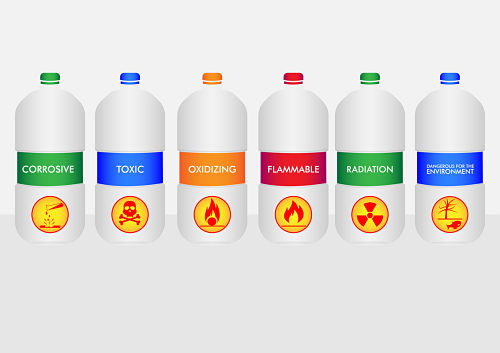How safe is your workplace?
Would you know if you had been exposed to harmful chemicals while at work?
Factories, construction, food preparation or cleaning are some of the more common employers using chemicals but hairdressers, florists, caterers, motor manufactures and agriculture also use regulated substances.
There are laws in place to protect you from illness caused by exposure to these materials and your employer has a duty to protect you from harm while at work.
Some substances can cause serious illness or at worst fatalities for those involuntarily exposed to them. Hazardous exposure can cause damage to the lungs, skin, nose, mouth, genes, internal organs, and eyes as well as risk of injury from combustion or explosion.
Contact dermatitis
Contact dermatitis is one of the more common work-related skin diseases, which falls under UK legislation with more than 7,000 cases reported in the UK every year. Although it is not fatal, it can be debilitating and can cause irritation, redness, cracking or blistering on the skin.
A failure to protect the skin can cause contact dermatitis and contact with soaps and cleaning materials or working with wet hands commonly cause work-related contact dermatitis. Occupations with the highest rates are florists, beauticians, cooks, hairdressers, and barbers, along with some manufacturing and health-care related occupations.
Control of Substances Hazardous to Health (COSHH) regulations are there to protect workers who may be exposed to hazardous substances and employers have a duty of care to follow these guidelines. Training must be offered to employees who are in contact with regulated chemicals and failure to provide a suitable risk assessment can lead to fines for the company.
COSHH regulations were introduced over 25 years ago. Workplaces failing to follow the guidelines either through the employer or employee are breaking the law and if found guilty face an unlimited fine.
According to the Health and Safety Executive (HSE), a firm was fined for breaching the regulations introduced to protect employees from contact dermatitis.
The HSE stated: “Workers at a company premises in Bristol were exposed to hazardous chemicals over a four-year period leading to the onset of a disease called ‘allergic contact dermatitis.’ One employee suffered four years of his skin blistering, cracking, splitting, and weeping because of this allergic dermatitis.
“Two other employees also suffered the symptoms of allergic dermatitis, including fingers and hands becoming so badly swollen and blistered that one could not do up his shirt buttons without his fingers splitting open. All three employees had been working with photographic chemicals.
“The company was fined a total of £100,000 and ordered to pay £30,000 costs. They were fined £30,000 for breaching The Health and Safety at Work Act 1974, and £10,000 for 6 separate breaches of the Control of Substances Hazardous to Health (COSHH) Regulations for not making adequate risk assessments, not preventing or controlling exposure of employees to chemicals, and for not providing any ‘health surveillance’ of employees at-risk. They were also fined £10,000 for not reporting a case of allergic contact dermatitis.”
Hazardous substances
The HSE was also involved in a recent case, which resulted in large fines for a Coventry-based company.
The fabrication division of Nasmyth Technologies was fined after four employees were exposed to hazardous substances that caused significant ill health and time off work as a result.
Between 150 and 200 litres of a chemical preparation, that included hydrofluoric acid, spilled across a large area of the factory floor.
Four workers were involved in the clean-up that took several hours. They were provided with inadequate personal protective equipment (PPE) and respiratory protective equipment (RPE) to undertake a clear up, for which they had no training. Some of them suffered ill health following the incident, which included an asthma attack, a severe headache, nausea, sore eyes, and throat. One of the workers, whose symptoms persisted, was referred by his doctor to a specialist for treatment. Exposure to such chemicals can have a lasting effect.
An investigation by the HSE found that there was significant non-compliance regarding management of substances hazardous to health. The company had failed to carry out a suitable and sufficient assessment and had not prepared for this emergency. One of the failings was that the RPE (face masks) provided did not have the correct type of filter for protecting against hydrofluoric acid gas.
Additionally, the type of RPE provided to workers relied on a good seal against the face to protect workers and no face fit tests had been undertaken to ensure the masks fitted the workers’ faces.
The workers involved were unshaven which meant their facial hair prevented an effective seal of the RPE to their faces.
Nasmyth Technologies pleaded guilty and were fined £13,000 and ordered to pay costs of £9,551.
Speaking after the hearing, HSE inspector, Berenice Ray said: “This incident could have so easily been avoided had the company firstly undertaken a suitable and sufficient risk assessment and then implemented the necessary controls, including emergency arrangements for dealing with a chemical spill and the provision of instruction and supervision to ensure safe working practices are followed.
“Companies should be aware that HSE will not hesitate to take appropriate enforcement action against those that fall below the required standards.”
Employer duty of care
According to the British Safety Council, employers have a responsibility to protect staff. Workplaces should follow the guidance produced by the British Safety Council:
- Exposure – Employers must prevent or control exposure to hazardous substances. This can include the provision of appropriate personal protective equipment (PPE) where necessary
- Control measures – Implement control measures around hazardous substances and ensure these are maintained and kept up to date, in full working order and clean where appropriate
- Instruction – Provide employees with information, instruction, and training around working with hazardous substances
- Procedures – Having procedures in place to deal with accidents and emergencies relating to hazardous substances
- Surveillance – Ensure employees exposed to hazardous substances are under adequate surveillance
- Risk assessments – Carry out COSHH risk assessments and ensure they are fit for purpose
- Limits – Ensure the use of hazardous substances does not exceed the Workplace Exposure Limit (WEL).
- Supervision – Check employees are carrying out tasks as they are supposed to
(source: BSC)
NV Legal
NV Legal has a specialist team of solicitors experienced in achieving successful outcomes for clients exposed to hazardous substances. If you or someone you know has been affected by these issues, contact us for legal advice. Consultations are FREE of charge and advice is provided by qualified solicitors, regulated by the Solicitors Regulation Authority.
Call – 03330 112732
Email – info@nvlegal.co.uk
Website – www.nvlegal.co.uk
Find us on social media – Facebook Twitter LinkedIn
USEFUL INFORMATION
https://www.hse.gov.uk/pubns/guidance/g403.pdf


